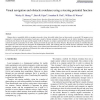Free Online Productivity Tools
i2Speak
i2Symbol
i2OCR
iTex2Img
iWeb2Print
iWeb2Shot
i2Type
iPdf2Split
iPdf2Merge
i2Bopomofo
i2Arabic
i2Style
i2Image
i2PDF
iLatex2Rtf
Sci2ools
113
click to vote
RAS
2006
2006
Visual navigation and obstacle avoidance using a steering potential function
Humans have a remarkable ability to navigate using only vision, but mobile robots have not been nearly as successful. We propose a new approach to vision-guided local navigation, based upon a model of human navigation. Our approach uses the relative headings to the goal and to obstacles, the distance to the goal, and the angular width of obstacles, to compute a potential field over the robot heading. This potential field controls the angular acceleration of the robot, steering it towards the goal and away from obstacles. Because the steering is controlled directly, this approach is well suited to local navigation for nonholonomic robots. The resulting paths are smooth and have continuous curvature. This approach is designed to be used with single-camera vision without depth information but can also be used with other kinds of sensors. We have implemented and tested our method on a differential-drive robot and present our experimental results. c 2005 Elsevier B.V. All rights reserved.
Local Navigation | Potential Field | RAS 2006 | Robot |
Related Content
| Added | 14 Dec 2010 |
| Updated | 14 Dec 2010 |
| Type | Journal |
| Year | 2006 |
| Where | RAS |
| Authors | Wesley H. Huang, Brett R. Fajen, Jonathan R. Fink, William H. Warren |
Comments (0)

